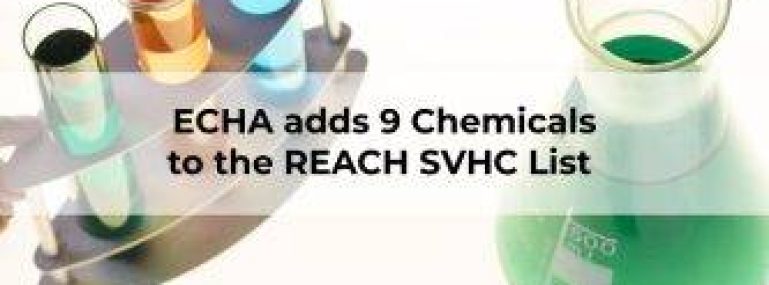On Jan 17th, 2023, The European Chemicals Agency (ECHA) recently added nine new substances to their list of substances of very high concern (SVHC). In addition to the newly added substances, the SVHC list now totals 233 substances, up from 224 currently.
REACH has added these substances to the SVHC list based on the previous public consultation, which considered persistence, bioaccumulation, and toxicity. Using these criteria, chemicals may be identified as posing significant risks to human health and the environment and therefore may require further regulation.
- Carcinogenic, Mutagenic or toxic to Reproduction (CMR) category 1 or 2 as per the directive 67/548/EEC
- Persistent, Bio accumulative and Toxic (PBT) or very Persistent and very Bio accumulative (vPvB) as per Annex XIII of REACH
- Any substance evaluated causing serious effects on human health or the environment
The additions list includes the following nine substances:
- Substance Name: 4,4′-sulphonyldiphenol (bisphenol S; BPS)
CAS number: 80-09-1
Reason for proposal: Toxic for reproduction (Article 57c); Endocrine disrupting properties (Article 57(f) – environment); Endocrine disrupting properties (Article 57(f) – human health).
Used in: Manufacture of pulp, textile, leather or fur, paper products etc. - Substance Name: Perfluoro heptanoic acid and its salts
CAS number: Group compounds hence not applicable
Reason for proposal: Toxic for reproduction (Article 57c); PBT (Article 57d); vPvB (Article 57e); Equivalent level of concern having probable serious effects to human health (Article 57(f) – human health); Equivalent level of concern having probable serious effects to the environment (Article 57(f) – environment).
Used in: stain-resistant fabrics, paper food packaging, and carpets - Substance Name: Melamine
CAS number: 108-78-1
Reason for proposal: Equivalent level of concern having probable serious effects to human health (Article 57(f) – human health); Equivalent level of concern having probable serious effects to the environment (Article 57(f) – environment)
Used in: spolymers and resins, Coating products, Adhesives and sealants, lab chemicals. - Substance Name: 1,1′-[ethane-1,2-diylbisoxy]bis[2,4,6-tribromobenzene]
CAS number: 37853-59-1
Reason for proposal: vPvB (Article 57e)
Used in: used as a flame retardant for many thermoplastic. - Substance Name: 2,2′,6,6′-tetrabromo-4,4′-isopropylidenediphenol
CAS number: 79-94-7
Reason for proposal: Carcinogenic (Article 57a)
Used in: reactive flame retardant and as an additive flame retardant in the manufacture of polymer resins, in products such as epoxy coated circuit boards, printed circuit boards and paper and textiles. - Substance Name: Barium diboron tetraoxide
CAS number: 13701-59-2
Reason for proposal: Toxic for reproduction (Article 57c)
Used in: paints and coatings. - Substance Name: Bis(2-ethylhexyl) tetrabromophthalate covering any of the individual isomers and/or combinations thereof
CAS number: Group of compounds hence not applicable
Reason for proposal: vPvB (Article 57e)
Used in: flame retardant, plasticizer for flexible polyvinylchloride, wire and cable insulation, carpet backing, coated fabrics etc. - Substance Name: Isobutyl 4-hydroxybenzoate
CAS number: 4247-02-3
Reason for proposal: Endocrine disrupting properties (Article 57(f) – human health)
Used in: coating products, fillers, putties, plasters, modelling clay, inks and toners etc. - Substance Name: reaction mass of 2,2,3,3,5,5,6,6-octafluoro-4-(1,1,1,2,3,3,3-heptafluoropropan-2-yl) morpholine and 2,2,3,3,5,5,6,6-octafluoro-4-(heptafluoropropyl) morpholine
CAS number: Group of compounds hence not applicable
Reason for proposal: vPvB (Article 57e)
Used in: in formulation or re-packing at industrial sites and in manufacturing etc.
As a whole, the addition of these nine chemicals to the REACH SVHC list is a positive step towards improving the safety of everyday products that contain chemicals. These changes require companies to be aware of the regulations and take the necessary steps to comply.
With ComplianceXL, companies can easily comply with the REACH Regulation and manage compliance documentation with ease.





